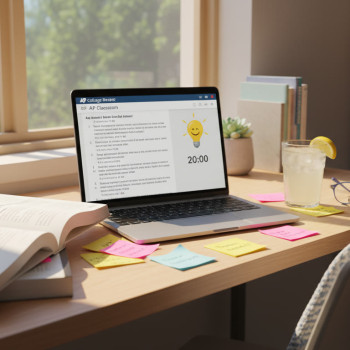Understanding the Two Worlds: AP Exams and the KSAT — A Parent’s Compass
For many parents in South Korea, the word “entrance exam” carries enormous weight. You’ve likely heard about the KSAT (Suneung), the single high-stakes day that shapes so many university paths in Korea. But increasingly, families — especially those eyeing international universities or global options — are weighing the College Board AP (Advanced Placement) pathway alongside or in place of the domestic route. This article is written for you: thoughtful, busy parents navigating cultural expectations, academic realities, and what’s best for your child’s future.

What each exam represents
At a glance, they look like apples and oranges. The KSAT (College Scholastic Ability Test) is Korea’s national college entrance exam — a single, high-stakes, centrally administered test taken by almost every university-bound Korean student. AP exams, by contrast, are individual subject tests developed by the College Board, typically taken throughout high school. APs can lead to college credit, advanced placement, or simply showcase academic rigor on an international transcript.
Key Differences Parents Should Know
Below are clear, parent-friendly contrasts that will help you weigh options based on goals, learning styles, and timelines.
1) Structure and Timing
- KSAT: One fixed day each year. Every minute counts. The results are decisive for domestic admissions.
- AP: Multiple subjects, usually taken in May (though there are alternative dates in some regions). Students can choose which subjects and years to take them.
2) Scope and Content
- KSAT: Comprehensive coverage of Korean high school subjects — emphasis on breadth and stamina under timed conditions.
- AP: In-depth, college-level content in specific subjects (e.g., Calculus AB/BC, Biology, Literature, History). Shows specialized strengths.
3) Stakes and Outcomes
- KSAT: Primary determinant for admission to most domestic universities. High correlation between KSAT scores and placement.
- AP: Valuable for international admissions (U.S., Canada, the U.K. increasingly), can earn college credit or advanced standing depending on institution policies.
4) Preparation Style
- KSAT prep: Often intense, classroom-driven, and test-focused — lots of practice under timed conditions.
- AP prep: Centers on depth, inquiry, and sometimes project-based or lab work (for sciences). Requires consistent subject mastery over time.
Why Families in Korea Choose One or Both
Understanding motivation helps decide practical next steps. Below are the most common rationales:
- Domestic university focus: KSAT remains the dominant pathway. Families prioritizing top Korean universities will typically invest heavily in KSAT prep.
- International university aspirations: AP exams strengthen an international application, demonstrating readiness for college-level courses.
- Keeping options open: Many families do both — invest in KSAT while students take a few APs in subjects they excel in or love.
Real-world example
Imagine Minji — strong in math and physics but unsure about studying abroad. She takes Calculus AB and Physics C APs to show depth for international programs while still preparing for the KSAT to keep top Korean options open. This hybrid approach gives admissions committees multiple signals: nationwide performance via KSAT and subject mastery via AP.
How Universities View Each Exam
Different institutions treat AP and KSAT results differently. In broad strokes:
- Top Korean universities weigh KSAT heavily. Supplemental materials — extracurriculars, essays, or AP scores — may help but usually aren’t replacements for KSAT performance.
- North American and many European universities assess APs positively as evidence of academic rigor. Strong AP scores paired with a well-rounded application can be influential.
| Admissions Context | Value of KSAT | Value of AP |
|---|---|---|
| Top Korean Universities | Very High (Primary) | Moderate (Supplemental) |
| U.S./Canada Universities | Low to Moderate (contextual) | High (shows college-level readiness) |
| International Options (U.K./Australia/etc.) | Low (used as background) | Moderate to High (depends on university policies) |
Practical Timeline: What to Do When
Timing matters. Here’s a simple timeline parents can adapt based on their child’s grade and goals.
Grades 9–10 (Early High School)
- Explore subjects: Let your child take challenging courses and discover interests.
- Encourage breadth: APs are best taken when a student has interest and some background; early exposure helps.
- Talk about goals: Domestic vs. international — this shapes focus later.
Grade 11
- Begin targeted AP prep if considering international universities. Popular APs include Calculus, Biology, Chemistry, Physics, English Literature, and World History.
- If domestic focus remains, increase simulated KSAT practice — timed sections, stamina building.
- Consider one or two APs to test the waters rather than a full AP load.
Grade 12
- Finalize exam schedule. If taking multiple APs, aim for 2–4 subjects spaced across the year.
- Perfect KSAT strategies if applying domestically — focus on time management, error patterns, and endurance.
- If applying abroad, coordinate AP results with application deadlines and university credit policies.
Study Strategies That Work — For Both Paths
There are shared skills that help on both AP and KSAT roads. Strengthening these will pay dividends regardless of choice.
Skills to cultivate
- Active recall and spaced practice: Instead of passive rereading, test knowledge frequently and space sessions out over weeks.
- Exam-specific practice: KSAT needs timed endurance; APs need depth, essay practice (for AP Lang/History), and lab familiarity (for AP sciences).
- Critical reading and problem-solving: Both tests reward students who can reason, synthesize, and apply concepts.
- Consistent schedule: Short, daily study blocks beat last-minute marathon sessions.
How parents can support — practically
- Provide structure: Help set a realistic weekly study timetable with built-in breaks.
- Encourage autonomy: Ask about progress, offer help to find resources, but let your child own the work.
- Protect well-being: Sleep, nutrition, and small rituals (short walks, creative outlets) sustain performance.
- Consider coaching: If your child needs targeted help, 1-on-1 guidance can make practice more efficient.
When Personalized Help Makes Sense
Many families find value in targeted instruction. Personalized tutoring is especially effective when:
- Your child struggles with a specific concept (e.g., AP Calculus limits) and needs tailored explanations.
- They need strategy practice for timed KSAT sections or essay rubrics for AP exams.
- They’re balancing schoolwork, extracurriculars, and exam prep — a customized plan keeps momentum without burnout.
Services like Sparkl’s personalized tutoring can fit naturally here — offering 1-on-1 guidance, tailored study plans, and expert tutors who adapt to your child’s pace. When used thoughtfully, such support can sharpen strengths and shore up weak spots without overwhelming the student.
Costs, Logistics, and Realities
Costs vary. KSAT prep may involve hagwon tuition or private coaching; AP prep could mean online courses, private tutors, or advanced school classes. For families balancing budget and impact, think about ROI:
- What’s the primary goal? (Domestic placement vs. international admissions)
- Which subjects offer the greatest leverage? (e.g., AP scores in your child’s strongest areas)
- Could a single excellent AP score plus solid school records be as persuasive as multiple weaker attempts?
Sample Study Plan: Hybrid Approach for a 16-Year-Old
Below is a realistic semester plan for a student aiming to keep both KSAT and AP doors open.
| Week Range | Focus | Activities |
|---|---|---|
| Weeks 1–4 | Diagnostic and Foundation | Full-length KSAT practice; AP diagnostic tests; identify weak topics; set weekly timetable. |
| Weeks 5–12 | Targeted Skill Building | Daily 45–60 minute AP content sessions (2 subjects), weekly timed KSAT section practice, weekly review sessions. |
| Weeks 13–20 | Exam Simulation | Bi-weekly full KSAT sims; AP practice FRQs and multiple-choice sets; tutor check-ins for strategy refinement. |
| Final 4 Weeks | Polish and Rest | Light review, focus on error patterns, sleep optimization, and stress reduction. |
Common Parent Concerns and Honest Answers
“Will APs hurt our KSAT-focused path?”
Not inherently. Taking one or two APs typically won’t harm KSAT prep if managed sensibly. The key is balance — avoid overloading the calendar and focus on subjects that align with strengths.
“Is it better to fully commit to KSAT?”
If your child’s goal is a top domestic university and resources are limited, a concentrated KSAT strategy is reasonable. But if there’s any interest in studying abroad, dipping a toe into APs can be valuable without jeopardizing KSAT preparation.
“How do admissions officers interpret KSAT and AP?”
For domestic admissions, KSAT remains a primary metric. For international admissions, AP scores are tangible proof of subject mastery. Admissions readers typically appreciate context — academic rigor, course availability, and demonstrated commitment.
Balancing Culture, Expectations, and Your Child’s Well-Being
Academic decisions in Korea don’t happen in a vacuum. There are family expectations, peer norms, and long-standing cultural meanings attached to university paths. As a parent, your role is partly practical — coordinating schedules and resources — and partly emotional — holding a steady, supportive presence.
Encourage open conversation with your child. Ask about dreams, not just scores. Sometimes the best choice is one that preserves curiosity and mental health, not just maximizes test results.
How to Decide: Checklist for Parents
- Define the final target: Domestic top university, abroad, or flexible options?
- Assess your child’s strengths and interests objectively.
- Estimate time available for prep after schoolwork and extracurriculars.
- Consider targeted tutoring if specific gaps or strategy needs exist.
- Plan one realistic, chronologically ordered exam schedule and revise it as progress is evaluated.
Closing Thoughts — A Gentle Roadmap Forward
Navigating AP and KSAT choices is rarely about one right answer. It’s about matching goals, learning styles, and family values. The KSAT anchors the domestic system — a concentrated, high-stakes test that demands endurance and strategy. APs offer modular depth and international relevance, especially when a student has specific subject strengths.
If your family is considering both, think in terms of priority and balance. Keep the conversation open with your child, set manageable study rhythms, and consider personalized support when the path becomes muddy. Thoughtful 1-on-1 guidance — like that offered by Sparkl, with tailored study plans, expert tutors, and AI-driven insights to highlight weak spots — can make preparation more efficient and less stressful.

At the end of the day, parents contribute most by keeping perspective: exams are important, but so is cultivating a resilient learner who can adapt beyond any single test. With clear priorities, realistic plans, and caring support, your child can make choices that lead to both success and lasting well-being.
Quick Resources for Next Steps
- Set a family meeting to outline goals and timelines.
- Schedule a diagnostic test for KSAT and one AP diagnostic per subject of interest.
- Consider a short trial of personalized tutoring to see if it improves focus and progress.
- Revisit the plan every 6–8 weeks to adapt as your child grows.
You’re not alone in this. With sound information, a sensible plan, and thoughtful support, you and your child can move forward with confidence — whether toward the KSAT, APs, or both.




















No Comments
Leave a comment Cancel